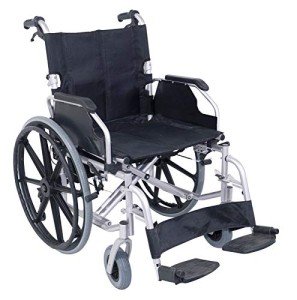Bariatric Transit 24 Inch Wheelchair
A bariatric wheelchair is perfect if you need a chair with a bigger seat width and greater weight capacity. This durable wheelchair has a nylon cushioned seat that extends 24 inches large with swing-away footrests. It has substantial 4 caster mobility and attendant locks for safe stops. The durable slide tube frame can support as much as 450 pounds.
Weight Capacity
When selecting a wheelchair on your own or for a liked one, it is very important to think about the weight capacity. Standard wheelchairs can accommodate up to 250 pounds, but bariatric chairs have the ability to support approximately 700 pounds. This distinction in capacity is the primary factor that bariatric wheelchairs are stronger and heavier than standard models.
To help chauffeurs safely transport guests who use bariatric wheelchairs, it is vital to have vehicles equipped with proper equipment. This consists of wheelchair lifts and ramps that can handle the increased size and weight of the chair. In addition, motorists need to receive training on how to steer these big mobility aids.
The Medline folding extra broad bariatric transport wheelchair has a large 24" seat and a carbon steel frame with rust- and chip-resistant chrome plating. It also includes easy-to-clean vinyl upholstery and swing-away footrests with a push-button adjustable height function. This sturdy wheelchair has a weight capacity of 500 pounds.
When selecting bariatric wheelchair for sale near me , it is necessary to request guidance from a doctor or mobility professional. They can evaluate your physical condition and advise the best mobility solution for you. They can likewise help you determine if Medicare or private insurance coverage covers the cost of your wheelchair.
Wheelchair Frame
A wheelchair frame is the primary assistance system that holds the other elements of the chair. The frames are made from a variety of products, including aluminum, titanium, and carbon fibre. Rigid manual wheelchairs are developed with efficiency in mind and use the principles of sports bicycle frames-- triangles are one of the strongest shapes offered and engineers have used this knowledge to create frames that create a stiff system that uses less energy for propulsion than more flexible frames.
The choice of wheelchair frame is typically based upon the needs and priorities of the customer as assessed by their OT/PT or other clinician. For instance, a front frame angle is a crucial configuration as it affects how well the client can move or self-catheterize. Likewise the seat to footplate height is an essential aspect for positioning and balance.
Many wheelchairs have the choice to be configured with a fixed or reclining frame. For those who require a more steady chair for stability or for transport in automobiles, a repaired frame is best. This is especially real for those who need a bariatric chair with a wider seat width or greater weight capacity.
Folding frames have a conventional "cross-brace" or X design that permits the chair to fold by bringing the side rails together, although there are other styles offered for folding chairs, such as a scissor brace frame (Kuschall Champion) which lowers the number of moving parts and for that reason can be lighter than the cross-brace designs. Other options for folding frames include swing-away legrests and detachable arms.

Lots of producers likewise provide a variety of alternatives for the wheelchair frame front end, such as the frame angle. A 90 degree frame angle positions the feet at a natural position for pressing, while a 75 degree frame angle places the feet more forward. The option of frame angle should be thoroughly considered as the more forward position may make it tough for the wheelchair user to get over challenges or may trigger a wheel capturing on dropped curbs and creating vibration.
Rigid frames are generally made from aluminium, although some models have a dual tube construction that is comparable to the sport frames used in biking, to help increase strength and stability. Carbon Fibre is another material utilized in the frame construction of some wheelchairs, providing an even stiffer and lighter frame.
